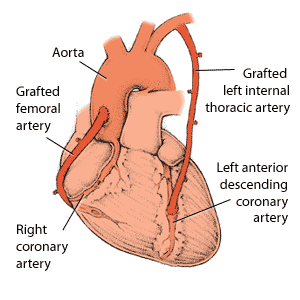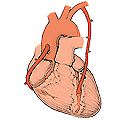Description of the procedure
In coronary artery bypass surgery, the surgeon removes a piece of blood vessel (a vein or artery) from somewhere in the body - usually from the leg, forearm, or chest - and attaches one end above and another end below a damaged section of the coronary artery. This creates a bypass and allows blood to flow around the narrowed artery to the heart.
When should this procedure be performed?
This surgery is usually recommended if there is disease of the left main coronary artery, disease in several vessels, a decrease in the pumping function of the heart, or if non-surgical methods have failed. In addition, if a heart valve needs to be fixed, bypasses of the arteries are performed at the same time, if this is needed. Your surgeon may perform bypasses on one or more arteries at a time, and the procedure may be repeated if necessary.
Why is this procedure performed?
Coronary artery bypass graft (CABG) surgery is performed to increase the flow of blood to the heart. Blood flow may be restricted because of coronary artery disease. Coronary artery disease is the buildup of plaque inside the arteries that feed into the heart. This buildup reduces the flow of blood to the heart so the heart may not get enough oxygen and nutrients. This is known as ischemia. This in turn causes shortness of breath, chest pain, and increases the risk of a heart attack.
Are there any risks and precautions?
Because CABG surgery is not a cure for coronary artery disease, there is the risk that the coronary arteries will again become blocked after a period of time, requiring further treatment.
The risks associated with CABG surgery include:
- bleeding
- cognitive problems, including difficulties with long-term memory, comprehension, calculation skills, and concentration (more common with use of the heart-lung machine)
- depression
- heart attack or stroke
- infection
- risks associated with use of general anesthetic, including side effects to the anesthetic, and breathing problems
- kidney failure
- death
What happens during the procedure?
CABG surgery is performed on an inpatient basis in the hospital while you are under general anesthetic, so you won't be awake during the procedure. The procedure takes from 3 to 6 hours depending on how many arteries need to be bypassed.
There are several steps to this procedure.
- Your surgeon will cut through your breastbone in order to have access to the heart and arteries.
- Next, the surgeon will remove a healthy piece of blood vessel from the leg, arm, or chest, which will be used to reroute blood flow to the heart.
- Your surgeon needs to stop your heart to perform the bypass, so you will be connected to a heart-lung bypass machine. During the grafting procedure, the heart-lung bypass machine will act in place of your heart, adding oxygen to the blood and pumping it through your body.
- Your surgeon will attach the healthy blood vessels around the damaged arteries, creating a route for your blood to bypass the narrowed and damaged arteries.
- Once the bypasses have been created, your surgeon will restart your heart, ensure the bypass is functioning properly, put the chest bone back together, and sew up your chest.
There are newer, less invasive techniques for performing CABG surgery. These include "beating heart surgery," which means the heart does not have to be stopped and there is no need for the heart-lung bypass machine. As well, there are minimally invasive techniques, which require smaller incisions rather than opening the whole chest.
How should I prepare for this procedure?
Your doctor or surgeon will provide you with a complete list of instructions before your surgery. In the weeks before the surgery, your doctor will likely order a number of blood tests as well as an X-ray and other tests to determine the size and shape of your heart.
You will require a coronary angiogram to confirm that bypass surgery is needed and possible and to locate the blockages in the arteries.
If you are on medication that affects your blood's clotting ability, your doctor may tell you to stop taking it before the surgery to decrease the risk of bleeding or blood clots. You may be given an anticoagulant before surgery that is different than the one you usually use.
People are usually admitted to the hospital the day before the surgery; you will be told by the nurse what needs to be done to prepare you for the surgery.
Do not eat for 8 hours before the procedure. You may continue to drink clear liquids until 2 hours before the procedure. If your doctor has recommended different times, follow the timing recommended by your doctor.
Tell your doctor or prescriber about all prescription, over-the-counter (non-prescription), and herbal medications that you are taking. Also tell them about any medication allergies and medical conditions that you may have.
Ask your doctor or pharmacist whether you need to stop taking any of your medications before the procedure.
What can I expect after the procedure?
Following surgery, you will likely spend one to two days in the hospital's intensive care unit, followed by several more days in the hospital. In the first few days after surgery, you will likely be connected to equipment that will monitor your heart, blood pressure, and other functions; to tubes to supply you with food and medication; and to other tubes to remove waste.
To reduce the risk of complications, your doctor may prescribe medications for pain and to prevent harmful blood clotting.
The incision may be sore and usually takes a few months to heal. During this time you should avoid disturbing the area by scratching it or unnecessarily touching it. After the surgery, you will need to support your chest bone by putting pressure on it with a pillow whenever you get up or cough.
A full recovery usually takes 2 to 3 months, but most people can return to nearly all of their previous activities within a few weeks. Driving is not recommended for at least one month after the surgery.
Recovery from coronary artery bypass graft (CABG) surgery requires an intensive rehabilitation program, including physical, respiratory, and occupational therapy. You may also need to make changes to your diet. It is important to adopt the recommended lifestyle changes following the procedure, as blockages in the coronary arteries can reoccur.
Results
CABG surgery does not cure coronary artery disease or stop it from progressing. As a result, blockages may develop in other arteries or in the blood vessel that was used as a bypass. How long the grafts stay open depends on the type of grafts used and the individual characteristics of each patient (e.g., lifestyle habits, genetic make-up).
Arterial grafts tend to last longer than vein grafts. Risk factors such as smoking or having abnormal cholesterol levels may cause either type of graft to narrow more quickly.
An estimated 2% to 3% of patients require a second surgery within 5 years. For people with vein grafts, about half of them develop chest pain caused by severe or complete blockages of the grafts after 10 years.
All material copyright MediResource Inc. 1996 – 2024. Terms and conditions of use. The contents herein are for informational purposes only. Always seek the advice of your physician or other qualified health provider with any questions you may have regarding a medical condition. Source: www.medbroadcast.com/procedure/getprocedure/Coronary-Artery-Bypass-Graft-Surgery


